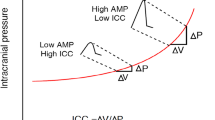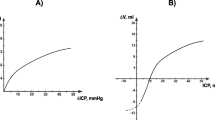Abstract
Introduction
Intracranial pressure (ICP) monitoring is currently an invasive procedure that requires access to the intracranial space through an opening in the skull. Noninvasive monitoring of ICP via the auditory system is theoretically possible because changes in ICP transfer to the inner ear through connections between the cerebral spinal fluid and the cochlear fluids. In particular, low-frequency distortion-product otoacoustic emissions (DPOAEs), measured noninvasively in the external ear canal, have magnitudes that depend on ICP. Postural changes in healthy humans cause systematic changes in ICP. Here, we quantify the effects of postural changes, and presumably ICP changes, on DPOAE magnitudes.
Methods
DPOAE magnitudes were measured on seven normal-hearing, healthy subjects at four postural positions on a tilting table (angles 90°, 0°, −30°, and −45° to the horizontal). At these positions, it is expected that ICP varied from about 0 (90°) to 22 mm Hg (−45°). DPOAE magnitudes were measured for a set of frequencies 750<f 2<4000, with f 2/f 1=1.2.
Results
For the low-frequency range of 750≤f 2≤1500, the differences in DPOAE magnitude between upright and −45° were highly significant (all p<0.01), and above 1500 Hz there were minimal differences between magnitudes at 90° versus −45°. There were no significant differences in the DPOAE magnitudes with subjects at 90° and 0° postures.
Conclusions
Changes in ICP can be detected using the auditory-based measurement of DPOAEs. In particular, changes are largest at low frequencies. Although this approach does not allow for absolute measurement of ICP, it appears that measurement of DPOAEs may be a useful means of noninvasively monitoring ICP.
Similar content being viewed by others
References
Böhmer A. Hydrostatic pressure in the inner ear fluid compartments and its effects on inner ear function. Acta Otolaryngol (Stockh) 1993;Suppl. 507.
Murakami S, Gyo K, Goode RL. Effect of increased inner ear pressure on middle ear mechanics. Otolaryngol Head Neck Surg 1998;118:703–708.
Büki B, Avan P, Lemaire JJ, et al. Otoacoustic emissions: A new tool for monitoring intracranial pressure changes through stapes displacements. Hear Res 1996;94:125–139.
Merchant SN, Ravicz ME, Rosowski JJ. Acoustic input impedance of the stapes and cochlea in human temporal bones. Hear Res 1996;97:30–45.
Lynch TJ, Nedzelnitsky V, Peake WT. Input impedance of the cochlea in cat. J Acoust Soc Am 1982;72(1):108–130.
Büki B, de Kleine E, Wit HP, Avan P. Detection of intracochlear and intracranial pressure changes with otoacoustic emissions: A gerbil model. Hear Res 2002;167:180–191.
Büki B, Chomicki A, Dordain M, et al. Middle-ear influence on otoacoustic emissions. II: Contributions of posture and intracranial pressure. Hear Res 2000;140:202–211.
Frank AM, Alexiou C, Hulin P, et al. Non-invasive measurement of intracranial pressure changes by otoacoustic emissions (OAEs)—a report of preliminary data. Zentralbl Neurochir 2000; 61:177–180.
de Kleine E, Wit HP, van Dijk P, Avan P. The behavior of spontaneous otoacoustic emissions during and after postural changes. J Acoust Soc Am 2000;107:3308–3316.
de Kleine E, Wit HP, Avan P, van Kijk P. The behavior of evoked otoacoustic emissions during and after postural changes. J Acoust Soc Am 2001;110:973–980.
Kemp DT. Stimulated acoustic emissions from within the human auditory system. J Acoust Soc Am 1978;64:1386–1391.
Probst R, Lonsbury-Martin BL, Martin GK. A review of otoacoustic emissions. J Acoust Soc Am 1991;89:2027–2067.
Shera CA. Mechanisms of mammalian otoacoustic emission and their implications for the clinical utility of otoacoustic emissions. Ear Hear 2004;25:86–97.
Doyle KJ, Burggraaff B, Fujikawa S, Kim J, MacArthur CJ. Neonatal hearing screening with otoscopy, auditory brain stem response, and otoacoustic emissions. Otolaryngol Head Neck Surg 1997;116:597–603.
Prieve BA. Identification of neonatal hearing impairment: a cornerstone for newborn hearing screening. Ear Hear 2000;21:345.
Magnano M, Albera R, Lacilla M, et al. Impedance measurement as a noninvasive technique for the monitoring of intracranial pressure variations. Audiology 1994;33:237–243.
Marchbanks RJ. Measurement of tympanic membrane displacement arising from aural cardiovascular activity, swallowing, and intraaural muscle reflex. Acta Oto-Laryngol 1984;98:119–129.
Voss SE, Shera CA. Simultaneous measurement of middle-ear input impedance and forward/reverse transmission in cat. J Acoust Soc Am 2004;116:2187–2198.
Chapman PH, Cosman ER, Arnold MA. The relationship between ventricular fluid pressure and body position in normal subjects and subjects with shunts: a telemetric study. Neurosurgery 1990;26:181–189.
Roede J, Harris FP, Probst R, Xu L. Repeatability of distortion product otoacoustic emissions in normally hearing humans. Audiology 1993;32:273–281.
Folowosele F. Auditory-based detection of changes in intracranial pressure: Control of middle-ear static pressure. Smith College, 2005. Undergraduate Honors Thesis.
Laird NM, Ware JH. Random-effects models for longitudinal data. Biometrics 1982;38:963–974.
Feldman HA. Families of lines: Random effects in linear regression analysis. J Appl Physiol 1988;64:1721–1732.
Fitzmaurice GM, Laird NM, Ware JH. Applied longitudinal analysis. New York: John Wiley & Sons, 2004.
Little RJA, Rubin DB. Statistical analysis with missing data, 2nd edition. New York: John Wiley & Sons, 2002.
Huttenbrink KB. The mechanics of the middle ear at static air pressures. Acta Otolaryngol Suppl 1988;451:1–35.
Plinkert PK, Bootz F, Voßieck T. Influence of static middle ear pressure on transiently evoked otoacoustic emissions and distortion products. Eur Arch Otorhinolaryngol 1994;251:95–99.
Knight LC, Eccles R. The effect of postural change and upper respiratory tract infection on middle ear pressure. Acta Otolaryngol 1991;111:1075–1082.
Tideholm B, Brattmo M, Carlborg B. Middle ear pressure: Effect of body position and sleep. Acta Otolaryngol 1999;119:880–885.
Gaihede M, Kjaer D. Positional changes and stabilization of middle ear pressure. Auris Nasus Larnyx 1998;25:255–259.
Hauser R, Probst R, Harris F. Effects of atmospheric pressure variation on spontaneous, transiently evoked, and distortion product otoacoustic emissions in normal human ears. Hear Res 1993;69:133–145.
Author information
Authors and Affiliations
Corresponding author
Rights and permissions
About this article
Cite this article
Voss, S.E., Horton, N.J., Tabucchi, T.H.P. et al. Posture-induced changes in distortion-product otoacoustic emissions and the potential for noninvasive monitoring of changes in intracranial pressure. Neurocrit Care 4, 251–257 (2006). https://doi.org/10.1385/NCC:4:3:251
Issue Date:
DOI: https://doi.org/10.1385/NCC:4:3:251




